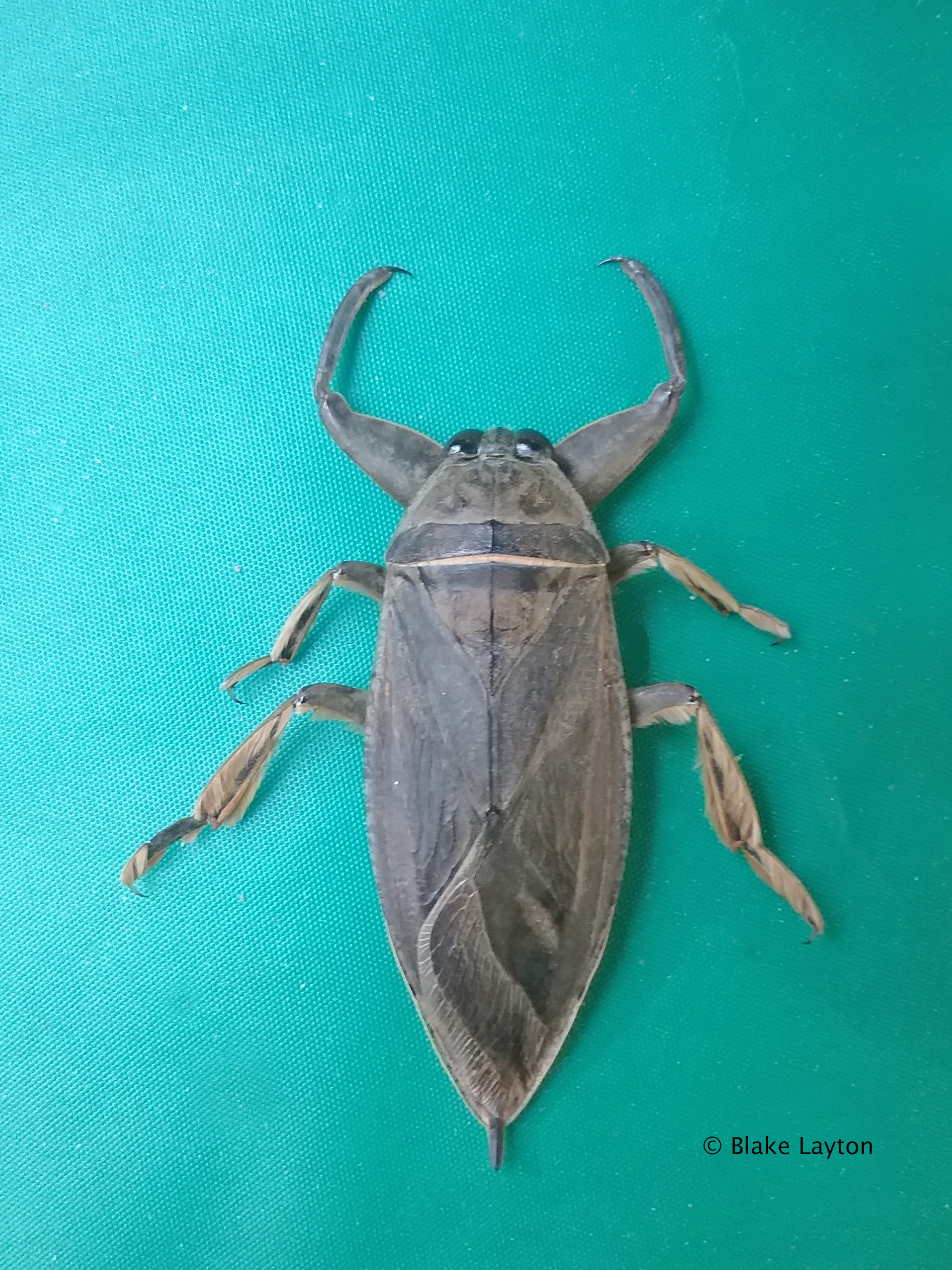Giant Water Bug, Vol. 10, No. 08
Benacus spp./Lethocerus spp.
Order: Hemiptera
Family: Belostomatidae
 An insect that preys on vertebrate animals.
An insect that preys on vertebrate animals.
Giant water bugs are also known as toe-biters and electric light bugs, and each name gives clues to their biology and habits. There are several species in this group, with two of the more common being Benacus griseus, colloquially called the Eastern toe-biter and Lethocerus americanus, “officially” known as the giant water bug. The bug in the photo is one of these, but it was released after the photo was taken and before species was verified.
Giant water bugs: These are big bugs that live in the water. In fact, they are some of our largest insects, with adults up to 2.5 inches long. These relatively common but rarely seen bugs live in ponds, lakes, and streams throughout the country. They are strictly meat-eaters. Small nymphs prey primarily on other insects and small aquatic invertebrates, but their diet expands to include vertebrate animals as they grow, and large nymphs and adults commonly prey on minnows; tadpoles; frogs; small snakes and turtles; and occasionally even young waterfowl. Prey are captured by grabbing them with those pincher-like front legs, stabbing them with their piercing mouthparts, and injecting toxic saliva, which quickly paralyses the victim and begins pre-digesting the body contents.
Toe-biters: They will bite, and it does hurt. Bites are rare because these insects are rarely encountered, and most people wisely avoid handling them when they do find one. Interestingly, but perhaps not surprisingly, biologists/entomologists and children are some of the most common bite victims. People who have been bitten indicate the bite is extremely painful--more painful than any other insect sting or bite they have ever experienced. Fortunately, the pain is relatively short-lived, and there are no long-term adverse effects. But do they really bite toes? It is hard to find a case of someone who had their toes attacked just because they were dangling them in the water, but barefoot waders are sometimes bitten. If you find one resting on the sidewalk while out walking in your flipflops, don’t poke it with your toe.
Electric light bugs: But if they are aquatic, why would you find one hanging out on a sidewalk? Adults don’t always stay in the water. On summer nights, they sometimes crawl out and fly away in search of mates. This is how they expand their territory or escape from bodies of water that are drying up. While flying at night they are attracted to artificial lights, and much like moths, they sometimes end up crash landing and becoming stranded near such lights. Back in the 1970s it was well-known among MSU entomology students that one of the best places to collect a giant water bug for your collection was at the tennis courts, which were often lit for nighttime players.
Giant water bugs also occur in other parts of the world, and some African and Indian species are even larger than our US species, over 4 inches long. They are also eaten or used as food seasoning in many parts of the world. Like stink bugs, these “true bugs” produce volatile compounds/odors, that help discourage predators or attract mates, and in parts of Thailand, India and other countries, giant water bugs are prized for their unique flavor. The flavor is variously described as being like banana or licorice, depending on location, and presumably species of bug.
Blake Layton, Extension Entomology Specialist, Mississippi State University Extension Service.
The information given here is for educational purposes only. Always read and follow current label directions. Specific commercial products are mentioned as examples only and reference to specific products or trade names is made with the understanding that no discrimination is intended to other products that may also be suitable and appropriately labeled.
Bug’s Eye View is now on Facebook. Join the Bug's Eye View Facebook group here.

